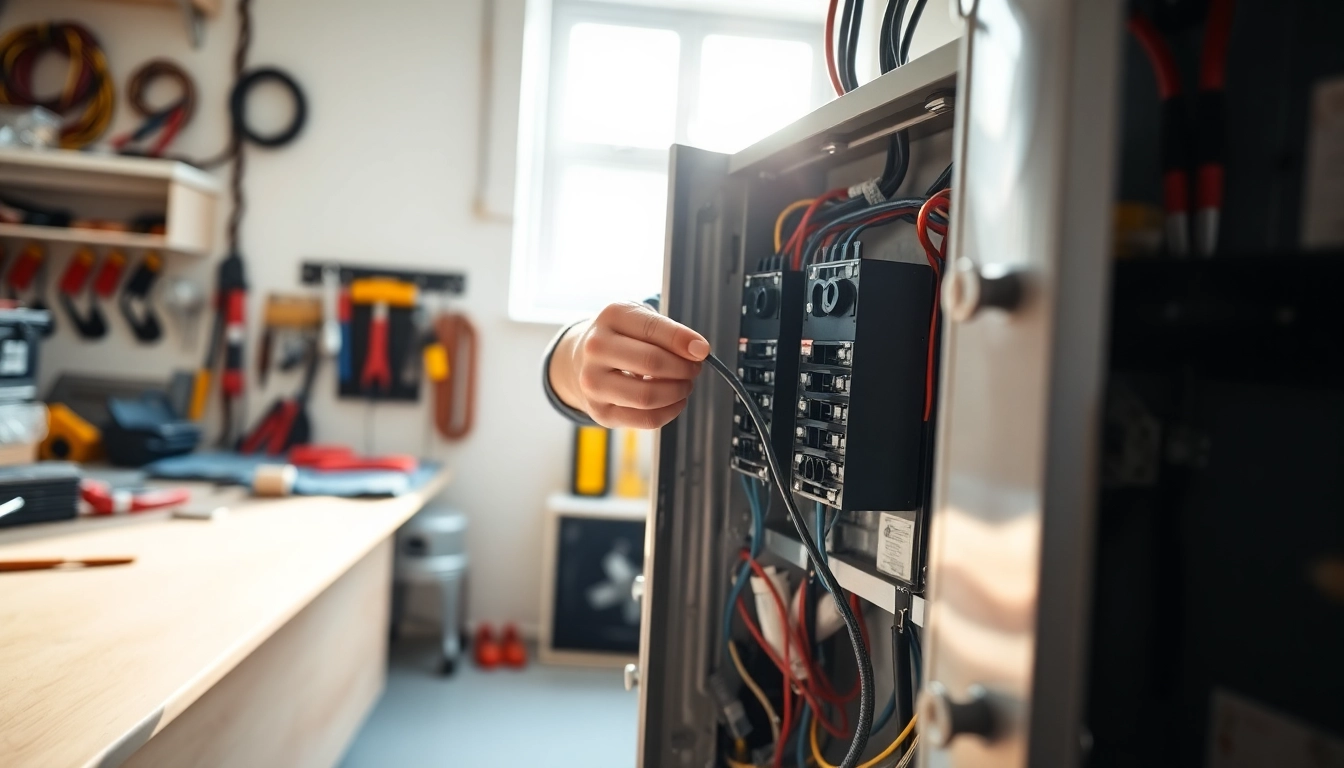Understanding the Electrical Panel: Core Concepts
What is an Electrical Panel?
An Electrical Panel, often referred to as a breaker box or fuse box, is a critical component of any home’s electrical system. This essential device serves as the central hub where electricity from the grid is distributed to every individual circuit within your home. It ensures that appliances and devices receive the right amount of power while simultaneously protecting the home from electrical surges and potential hazards. The panel usually contains circuit breakers or fuses that interrupt the flow of electricity when an overload or fault occurs, providing an important safety mechanism to prevent electrical fires and equipment damage.
Components and Functions of an Electrical Panel
Understanding the components and functions of an electrical panel can empower homeowners to maintain their electrical systems better. Key components include:
- Main Breaker: This is the first line of defense and acts as the switch to control the entire electrical supply to the house. It can cut off electricity in emergencies.
- Individual Circuit Breakers: Each circuit breaker corresponds to a specific area or appliance, providing control and protection to that particular circuit.
- Bus Bars: These are metal strips that distribute electricity to individual breakers. They play a crucial role in conducting current safely through the panel.
- Grounding and Bonding System: This component connects the electrical system to the earth, reducing the risk of shock or fire by providing a path for stray electricity.
- Neutral Bus Bar: This is where all the neutral wires from various circuits converge, ensuring that electricity flows properly.
The electrical panel’s functions include distributing power to circuits, protecting against overloads, and providing convenient access for repairs or upgrades.
Common Types of Electrical Panels
Electrical panels are available in several types, catering to different needs and specifications. The most common types include:
- Fuse Boxes: Older homes may still utilize fuse boxes, which contain fuses instead of circuit breakers. When a circuit is overloaded, the fuse blows, requiring replacement.
- Circuit Breaker Panels: These are the most common type in modern homes and can easily reset after tripping protecting circuits.
- Main Breaker Panels: These include a single main breaker to shut off power entirely and can have multiple branch circuits.
- Main Lug Panels: Ideal for new construction or additions where a separate main breaker is present in the service disconnect, these panels only have lugs to connect incoming wires.
Each type serves specific functionalities and selecting the right one is crucial for ensuring effective power distribution and safety in your home.
Signs You Need to Upgrade Your Electrical Panel
Warning Signs of an Overloaded Panel
Recognizing the early warning signs of an overloaded electrical panel is critical. Symptoms include:
- Frequent Circuit Breaker Trips: If you notice that your breakers are tripping often, it can indicate that the panel is overwhelmed with electrical demand.
- Flickering or Dimming Lights: Lights that flicker or dim when appliances are used suggest that the panel cannot handle the load effectively.
- Burning Smell: A burning smell near the electrical panel is an urgent sign that you must take seriously as it could indicate overheating.
- Buzzing Noises: Unusual sounds from the panel may signal faulty wiring or overloaded circuits, warranting immediate attention.
Benefits of Upgrading Your Electrical Panel
Upgrading your electrical panel offers numerous advantages:
- Increased Capacity: Newer panels provide higher power capacities, allowing you to accommodate modern appliances and electronic devices.
- Enhanced Safety: Updated panels come with better safety features, reducing the risk of electrical fires and ensuring compliance with current electrical codes.
- Improved Energy Efficiency: By managing energy flow more effectively, a new panel can lead to lower utility bills.
- Smart Technology Integration: Many modern electrical panels are designed to integrate with smart home technologies, offering advanced monitoring and control options.
Transitioning to a new electrical panel can significantly improve your home’s functionality and safety.
Safety Considerations for Upgrading
Safety is the foremost concern when upgrading your electrical panel. Key considerations include:
- Hiring a Qualified Electrician: Electrical work should be performed by licensed professionals who understand local codes and safety standards.
- Understanding Local Codes: Before any upgrade, familiarize yourself with local building codes that dictate panel specifications and electrical standards.
- Proper Grounding: Ensure that the new panel is correctly grounded to prevent electrical hazards.
- Regular Inspections: Schedule periodic inspections of your electrical system to catch risks before they escalate.
Choosing the Right Electrical Panel for Your Home
Factors to Consider When Selecting an Electrical Panel
Selecting the right electrical panel requires careful consideration of several factors:
- House Size: Larger homes generally need panels with higher capacities (200 amps is common for modern homes).
- Future Electrical Needs: Consider your future power consumption based on planned renovations or new appliances.
- Type of Electrical System: Assess whether a single-phase or three-phase panel is most suitable depending on your electrical load.
- Budget: Prices can vary dramatically depending on features, brands, and installation costs. Assess your budget before making a choice.
Top Brands and Models Available
When it comes to electrical panels, choosing reputable brands can assure quality and safety. Some popular brands include:
- Square D: Known for reliability and innovation, Square D offers a variety of circuit breakers and panels for residential and commercial use.
- Siemens: Siemens provides panels designed for advanced technology integration and robust energy management.
- Challenger: An affordable brand offering panels that are easy to install and service.
- GE (General Electric): Known for comprehensive safety features and ease of use.
Installation and Maintenance Tips
Proper installation and maintenance of your electrical panel can ensure longevity and safety:
- Follow Manufacturer Guidelines: Always adhere to the manufacturer’s instructions for installation.
- Consult an Electrician: Even if you’re handy, it’s often best to consult with or hire a professional for installation.
- Regular Cleaning: Keep the panel free from dust and debris, ensuring ventilation and functionality.
- Check Connections: Periodically inspect connections to ensure they are tight and corrosion-free.
The Installation Process: What to Expect
Steps in Replacing Your Electrical Panel
Replacing an electrical panel is a detailed and critical task. Key steps in the process include:
- Preparation: Gather necessary tools and equipment and ensure all safety protocols are in place.
- Shut Off Power: Turn off the main power supply to prevent accidents.
- Remove the Old Panel: Carefully disconnect and remove the existing panel, ensuring no wires are damaged.
- Install the New Panel: Mount the new panel and connect it securely to the service line and circuits.
- Test the System: After installation, test each circuit to ensure everything is functioning correctly.
- Inspect: Have an electrician inspect the new installation to confirm safety.
Hiring a Professional vs. DIY Installation
While some homeowners may consider a DIY approach to installing a new electrical panel, there are several advantages to hiring a licensed electrician:
- Expertise: Professionals have the technical know-how to handle complex installations safely.
- Legal Compliance: An electrician ensures that the installation complies with local codes and regulations.
- Time Efficiency: Licensed electricians can often complete the installation more quickly and effectively than untrained individuals.
- Warranty Protection: Many professional installations come with warranties that cover future problems.
Timeline and Cost Estimates for Installation
The installation timeline can vary depending on the complexity of the job and any unexpected issues. On average, you can expect the installation process to take between 3-6 hours. Cost estimates may fall between:
- Panel Cost: $250 to $800 depending on the brand and specifications.
- Installation Fees: Typically range from $200 to $500.
- Total Cost: Overall expenses could vary between $450 to $1,300, inclusive of the panel and labor.
Always request multiple quotes from licensed electricians to find the best deal.
Optimizing Your Electrical Panel for Modern Needs
Integrating Smart Technology with Your Electrical Panel
As technology evolves, integrating smart devices with your electrical panel can enhance your home’s functionality:
- Smart Breakers: These allow homeowners to monitor usage and control circuits remotely from their smartphones.
- Energy Monitoring Systems: Track your household energy consumption in real-time, providing insights for efficient use.
- Home Automation: Connect your electrical panel with smart home systems to control lighting, heating, and appliances seamlessly.
Future-Proofing Your Electrical System
To future-proof your electrical system, consider the following:
- Assess Load Requirements: Anticipate increased energy demands with home add-ons or new appliances.
- Invest in High-Capacity Panels: Opt for panels with higher amperage ratings (200 amps or more is recommended for larger homes).
- Consider Renewable Energy Options: If you plan to install solar or other renewable energy sources, ensure your system can support this integration.
Regular Maintenance and Upkeep Strategies
Proper maintenance of your electrical panel can extend its lifespan and efficiency. Here are effective strategies:
- Routine Inspections: Schedule annual electrical system evaluations with a licensed electrician.
- Keep Electrical Panels Accessible: Ensure that access to your panel is clear and unobstructed for safety and convenience.
- Document Changes: Keep a log of any electrical work performed for future reference or troubleshooting.


